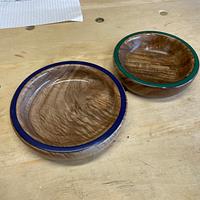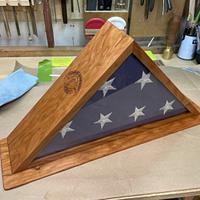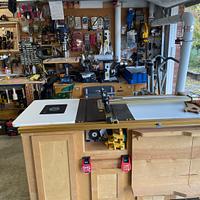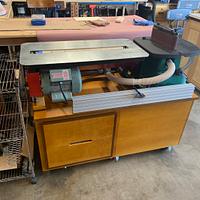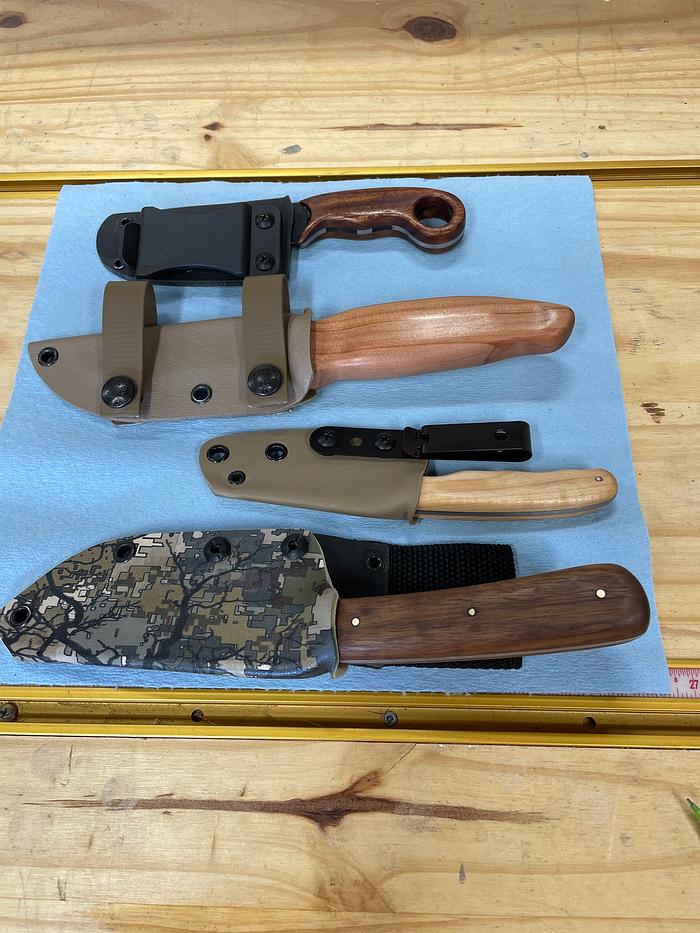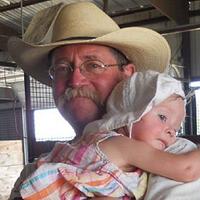
RyanGi
in about 3 years
More from RyanGi
2022 knife swap project
I started with a couple Moralniv blanks (a model 1 and a model 2000) as testers. Both of these are hidden tang blades, which make them a bit of a pain to add a handle to, as I would learn. Well, the Model 2000 made it, the smaller model 1 didn’t. I butchered it pretty bad. I picked up a couple different full tang blades on line and started working with them.
One of the reasons I really like swaps is because I usually get a new tool or two out of it! This one was no exception. I have been eyeing a 2X72 grinder for a while, but this was the perfect excuse to buy one. I picked up a beautiful grinder from Origin Blade Maker in Oregon. Wow! What a tool!! I also made a small blade vise with a design that I stole from the Internet. It’s really just a piece of pipe with some wood ‘jaw’ inserts inside of it and a couple thumb screws to tighten it down. I overdid it, as I like to do, and powder coated the whole thing so it looks nice. What I really like about this vise is that it’s a super simple design. The pipe fits into a block of wood with a kerf on top of it, and when you want to tighten it in the position, you just place the whole thing in a bench vise and clamp it down. This allows three axis of movement with very little hardware other than the thumb screws and bench vise. It works really really well!
I fitted each of the knives to their respective handles and then worked the shapes in with both handtools and the 2X72. New to this project for me was also using 100% pure Tung oil. It was a little bit of a tedious process, but I like the natural outcome of it and it’s a super neat material to work with. After that, I buffed up the knives, both the handles and the blades, on a couple sets of polishing wheels that I also picked up for the swap. Wow! I guess I did buy a couple of tools for this one!
Lastly were the Kydex sheaths. This took a little bit more trial and error but it’s actually pretty easy to do. I got a cheap toaster oven from the Goodwill shop and it worked just perfect. I tried to make the different attachments for the Kydex as varied as I could think of. A couple of them are able to be either horizontal mounted or vertical mounted, and a couple of them use clips they can be moved into different positions to vary how they’re carried. Most of the sheathes are actually interchangeable with the different attachment points, but obviously each sheath only carries its own respective knife. I feel like how you carry a knife is a fairly personal thing, so I tried to give the recipient as many options to swap stuff around as possible!
Lastly, I did a little bit of engraving using a new El-Cheapo laser engraver that I got off Amazon. It actually works surprisingly well and has become a new commonly used tool my shop for makers marks and the like.
This was a really fun swap to participate in, I enjoyed learning new skills, and I am looking forward next time to forging my own blades possibly! I guess that’ll mean some new tools… Again!














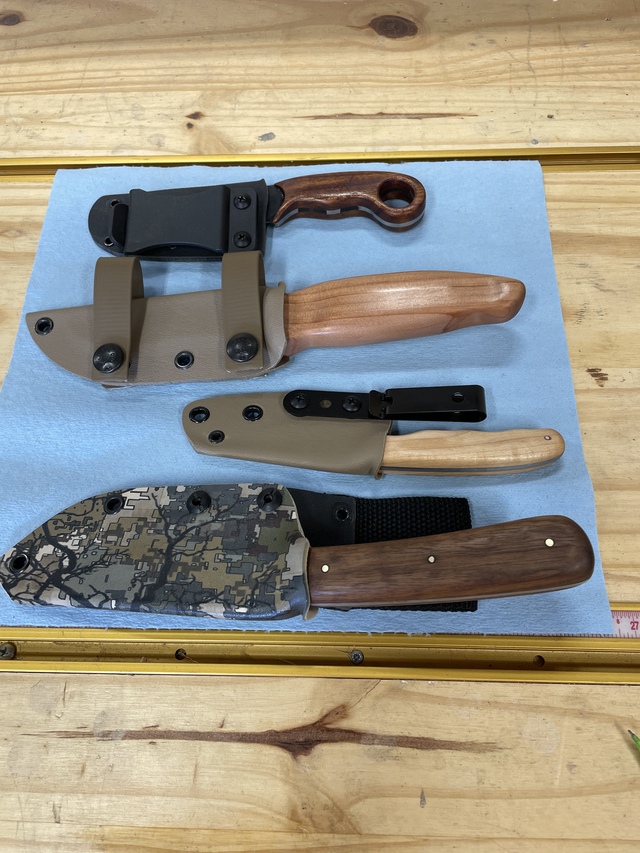
Ryan/// ~sigh~ I blew up another bowl. Moke told me "I made the inside bigger than the outside".
8 Comments
working with my hands is a joy,it gives me a sense of fulfillment,somthing so many seek and so few find.-SAM MALOOF.
Ryan/// ~sigh~ I blew up another bowl. Moke told me "I made the inside bigger than the outside".
Main Street to the Mountains
For a knife like the #1 Mora, I also have a piece of O-1 steel cut to roughly the same shape that I’ll heat red-hot with a MAPP torch, then use that to burn a hole for the tang if I really want to do a solid handle. The #1 tang gets narrower most of its length, so that works ok (and again, epoxy will fill any voids).
The final trick is if I’m making a stacked (leather or birch bark) handle, I’ll punch holes in each layer with a leather punch and thread the pieces on, compressing them every few. Need a bolster on the end of the tang to hold things together. I use a die to thread the very end of the tang, crank on a nut, peen the tang over, then grind it all to an aesthetic shape.
Once I get my projects migrated over, I’ll try to remember to come back and point you to them, too.
May you have the day you deserve!
I basically bored out a rough, deep slot in the handle that was just a little loose, then filled it with epoxy and inserted the tang. I braced the whole thing with a couple clamps to hold the orientation until it dried. I knew it wasn’t the correct way to do it, but I wanted to try a handle with no visible lines/splits. The cherry handles Mora 2000 came out ok, but that’s because it had enough meat to deal with my sloppy boring attempts. The smaller handle for the model 1 ended up with weak points, a couple holes, and finally a split. ☠️
Having never done any of this, it was all new. And I’m not really a knife guy. I mean, I’ve carried a folding knife probably every day for 20 years, but usually just something small and almost sharp, but I was always interested in something very thin and with a clip on it…not exactly what we were going for here. Regardless, I very much enjoyed this swap and I’d like to make more knives, I just need to find some way to get rid of them after the build!!
Ryan/// ~sigh~ I blew up another bowl. Moke told me "I made the inside bigger than the outside".
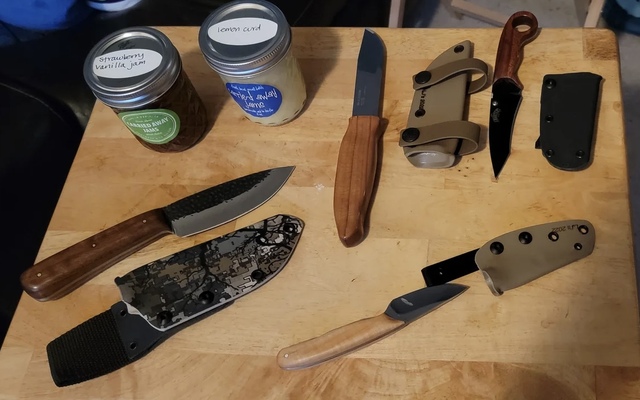
Ryan/// ~sigh~ I blew up another bowl. Moke told me "I made the inside bigger than the outside".
The kydex is cool. Kenny sent me a knife with a kydex sheath.
"Duck and Bob would be out doin some farming with funny hats on." chrisstef
Ryan/// ~sigh~ I blew up another bowl. Moke told me "I made the inside bigger than the outside".









